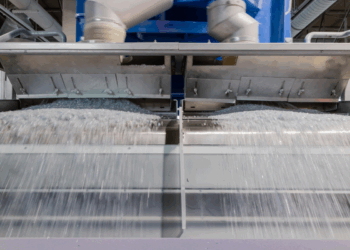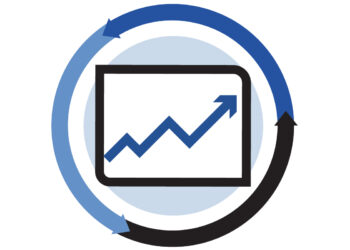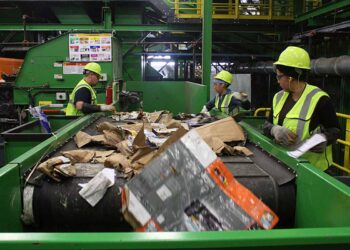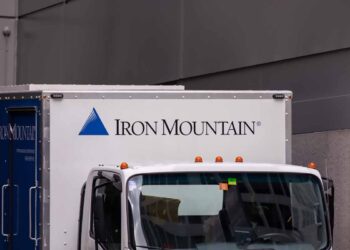Although the North American containerboard market saw a surge of new recycling machines in 2023, producers are waiting to see how the market develops before investing in new capacity, according to experts at Fastmarkets.
That was a key takeaway from a recent presentation from the research and price index firm, featuring experts from various regions. The session, “State of the Containerboard Industry and How to Get Back to the New Normal,” was moderated by Jon Rager of Fastmarkets.
In 2023, containerboard producers were matching capacity to the new demand reality, said Derek Mahlburg, director of North American graphic paper and packaging at Fastmarkets. Although Europe is slated for significant capacity expansions, North American producers are waiting to see if operating rates get closer to normal before investing in new capacity, he said.
In Europe, new capacity drivers include ongoing legislative efforts to move away from plastic packaging, said Alejandro Mata, director of Europe packaging and graphic papers at Fastmarkets. Poor performance in other paperboard segments such as graphic containers – particularly in 2018 and 2019 – has led companies there to shift production to containerboard, he said, increasing demand for both virgin and recycled fiber.
Worldwide capacity saturation
Despite the growth in demand, globally there are 22 million tons of overcapacity, concentrated in Europe and Asia, which has resulted in low operating rates, Mata said. Global operating rates reached all-time lows in 2022, he said, and “still are not really where they should be.”
North America saw a similar decline. From 2010 through 2019, North American production ran consistently around 95% or higher of nameplate capacity, according to Fastmarkets data, but dipped to nearly 85% in 2022.
Nevertheless, North American run rates have mostly recovered.
“Besides Asia, the U.S. is the outlier,” Mahlburg said, adding that North America has “seemingly higher prospects for returning to normal levels.”
One factor boosting U.S. operating rates is an increase in exports of virgin containerboard to Mexico, where packaging firms are using the U.S. product instead of utilizing domestic production capacity. That’s had the effect of lowering Mexico’s operating rates, but bolstering them in the U.S.
In Asia, run rates have not declined proportionally with demand, said Beth Lis, vice president of Asia paper and packaging at Fastmarkets. This is largely a result of a “founder effect,” where producers are willing to sacrifice profit margins to maintain market share, she said.
Following implementation of China’s National Sword initiative in 2018 – which banned most post-consumer material imports – Southeast Asia saw a wave of capacity investment, Lis said, to continue to get higher-quality OCC from the U.S.
Looking ahead, Fastmarkets expects European operating rates to return to the 2010-2019 average by 2026, Mata said. Fastmarkets data shows European operating rates around 90% during that time period, compared to 2022-2024, when Europe has been below 85% utilization.
A major headwind for Europe is the macroeconomic picture, Mata said. Consumer confidence remains subdued, with people buying less and saving more. However, the increase in savings later could help consumer spending return more quickly to previous levels, he said.
In addition, Asian e-commerce companies such as Alibaba are increasing market share and shifting demand for containerboard away from Europe, and subsequently reducing demand there.
What to watch
Although inflation has been among the top issues globally, in North America the numbers to watch are how consumer wages are doing compared to inflation, Mahlburg said.
The disconnect between wage growth and inflation will continue to be a major factor in driving containerboard demand – and subsequently prices – as well as producers’ capacity decisions, he said.
Another dynamic that will affect containerboard markets is the recent trend of nearshoring. Supply chain disruptions during the pandemic brought into sharp focus the risks involved with concentrating production in one region.
As a result, companies are trying to place production closer to home, to mitigate risks and price volatility, the panelists said. Some U.S. manufacturing is being relocated from Asia to the northern border of Mexico, supporting the U.S. economy of service and paper exports to Mexico, and reinforcing manufacturing exports to the U.S., they said.
Regulatory ripple effect?
A less direct factor to keep an eye on is Europe’s new Regulation on Deforestation Free Products, known as EUDR, which is set to take effect Dec. 30. The law requires companies to prove their products did not come from land that was deforested and to demonstrate they comply with the laws in the country they were produced, among other points.
Although recycled materials will not need to comply with the new law, one possible consequence is increased consumption of recovered fiber in Europe’s paper and board markets, Mata said.
For North America, there are many possible scenarios, Mahlburg said. The U.S. exports Kraftliner to Europe, and imports bleached and coated liner grades from the EU, he said, adding that both of those trade flows could be affected.
In addition, EUDR could block North American mills from exporting to Europe, due to the difficulty in tracking where fiber and residuals are really coming from, he said.
“It’s important for people to understand that just because they’re not buying in Europe or doing business in Europe, they may still be affected by this,” Mahlburg added.

























